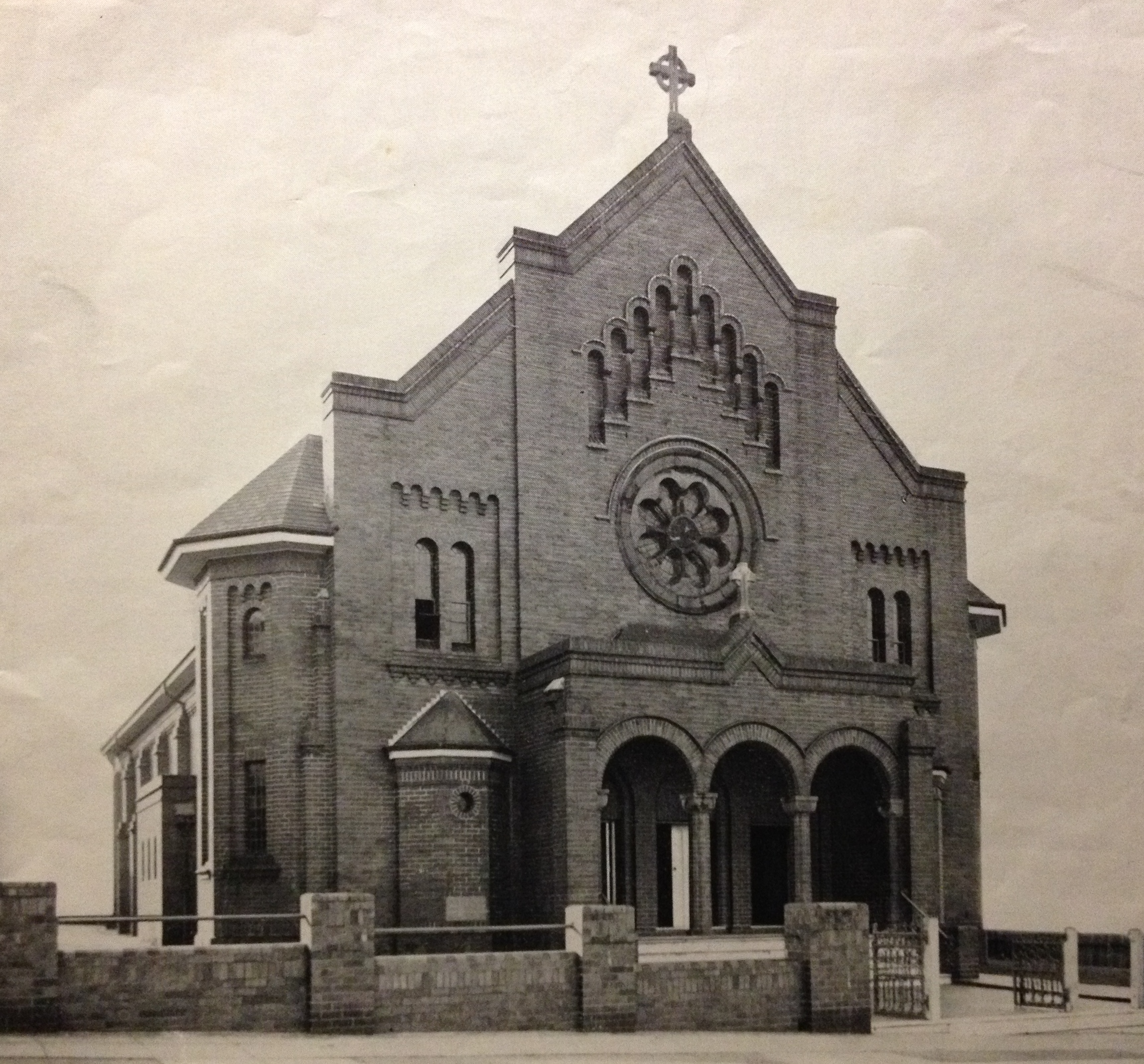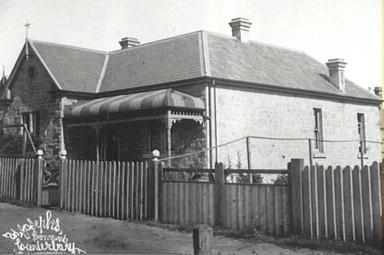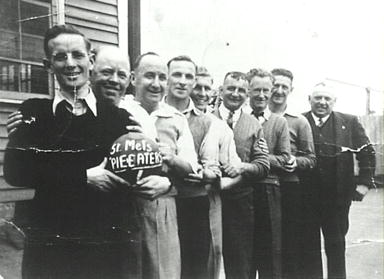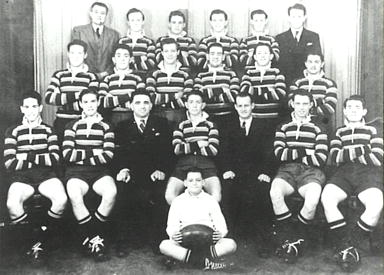History
History of St. Mel’s Parish




Canterbury in the infant stage:
Up until the early 19th century, the population in Canterbury was small and there was no church there. Catholics had to make a long journey to St Mary’s Cathedral for Mass. It was quite a distance, especially as most had to walk!
From around 1840 to 1858, some Sugarworks were constructed and operated in Canterbury, which attracted workers to the area. There was a slight increase in the population. Benedictine priests from the Cathedral began to make irregular visits to Canterbury to say Mass and teach the children catechistic in different locations.
In 1851, St Thomas of Canterbury’s Parish, Petersham (now Lewisham), was set up and the Church was soon built there. Canterbury belonged to this newly established parish. It would have taken less time to travel to Mass. Priests from Petersham also came to Canterbury to say Mass once every month at various locations until they settled at Canterbury Town Hall.
In the early 1880s, a convent, schools and a small church were opened in Ashfield. These were still parts of Petersham’s Parish. It was only in 1891 that Cardinal Moran was planning to make Ashfield and Canterbury a separate parish, following the Government’s decision to build a railway from Sydenham to Belmore via Canterbury. On the 14th January 1894, the Vincentian Fathers were appointed to the new parish. Since there was no church in Canterbury, the Vincentian Fathers continued the arrangement made by the priests from Petersham and celebrated Sunday Mass in the Canterbury Town Hall.
St Anthony’s Parish Canterbury:
The arrangement did not last long as our own church was built and named St Anthony’s Church, Canterbury. Cardinal Moran blessed and opened the Church on the 11th November 1894. This was a wooden Church which was also used as a school and it was located at the junction of Howard, High and Canton Streets, Canterbury (near Canterbury South Public Primary School). The church was 27 feet wide by 55 feet long (approx 8m x 16m) and cost 300 pounds. Our parish was still part of Ashfield Parish and the Vincentian Fathers came regularly to celebrate Mass at St Anthony’s Church.
The first school was opened on the 21st January 1895 by the Good Samaritan Sisters who travelled from their convent at Marrickville. There were 70 pupils.
In January 1901, the Sisters of St Joseph succeeded the Good Samaritan Sisters in the operation of the school. The Sisters of St Joseph then purchased a house at 9 Fore Street, Canterbury, for use as a convent.
The Catholic people of Canterbury were active in their support of the church, convent and clergy. An Altar Society and branches of the Sacred Heart Association for men and women were also formed. In 1897, the first Conference of the St Vincent de Paul Society, Canterbury, was opened. Every three years a Mission was given at St Anthony’s and a regular series of entertainment was held to raise funds for the parish.
Canterbury became a separate Parish in November 1905 with Fr James Dalton as the priest-in-charge, taking over from the Vincentian Fathers. Fr Dalton, an Irishman, was the first known resident priest at Canterbury, living at George Street (Canterbury Road).
The opening of the railway line to Bankstown had transformed the Campsie area into one of the most progressive suburbs of Sydney within a few years.
In 1909, after succeeding Fr Dalton as the priest in Canterbury and, seeing the residential growth of Campsie, Fr Richard Condon purchased with his own money ‘300 feet of land at Campsie at a cost of 30 shillings a foot’. Because of the difficulties of cost and distance faced by parishioners in attending St Anthony’s and also ‘owing to the growth of population at Campsie’, a decision was made in 1911 to find a more central site for the church around Campsie. In offering his land in Duke Street, Fr Condon informed the Archbishop, ‘I bought the land in 1909 and I am selling it for what it cost me. I bought it on my own responsibility.’ (See Attachment 1).
Fr Condon informed the Archbishop that there was still a remaining corner block which should be purchased but that should pose no problems, once the owner realized that he would have 123 noisy school children as neighbours. Needless to say, the block was acquired. Later on, this block with the long side facing Evaline St became the site for the Presbytery and the front of the new church. Unfortunately, in 1914 when everything was completed, Fr Condon passed away.
Fr Kenny and the Founding of St Mel’s Parish:
In 1915, probably toward the beginning of the year, Fr Patrick Kenny was appointed the first Parish Priest of Campsie. He was born in Ballymacormack, Co Longford, Ireland. Within a week of appointment, Fr Kenny began to work for the setting up of the new Parish. A few months afterwards, he supervised the transfer of St Anthony’s Church/School from Canterbury to its new site in Duke Street, Campsie, by horse-drawn wagons. The date of the move was not known.
Very early in his position as a Parish Priest, Fr Kenny had already the intention of changing the name of the Parish to St Mel. In a letter dated the 5th April 1915 to Fr Whyte, the Chancellor and probably his good friend, Fr Kenny posed the suggestion to him when he asked, “By the way just give me your opinion on the new name I have for this place. “St. Mel’s Campsie.” It goes alright does it not.” (See Attachment 1)
On Sunday the 8th August 1915, Archbishop Michael Kelly visited Campsie and blessed and laid the foundation stones of a new presbytery and convent and perhaps of the church/school. In his welcoming speech, Fr Kenny mentioned that, “The laying of the foundation stone of the new convent and presbytery was an historic occasion, because it was the founding of a new parish under the patronage of St Mel, one of Ireland’s early saints and evangelists.” He then explained why this came about by saying, “that I would like to give that name, you (Archbishop) graciously acceded to my request, and for that I desire to thank you. The name and its association are dear to me, and with God’s blessing we will be worthy of so great a saint.” The official year for the founding of St Mel’s Parish, including St. Mel’s School, was therefore given as 1915. (See Footnote 1)
In a letter written around this time, Fr Kenny mentioned that the population of the Parish was given as 1,650, with 160 children attending the Sunday school. Easter communions had totaled 1,010, the Sisters of St Joseph conducted the school, and the parish debt was 3,196 pounds.
In November 1915, the Archbishop once again came to Campsie for the blessing of a group of parochial works. On this occasion, the town clerk and also a parishioner paid tribute to Fr Kenny by saying that, “he proved his worldly knowledge and high commercial ability in the excellence of the work he had performed for the benefit of the parishioners. Father Kenny was a model priest, a credit to the Church, and for him every Catholic in the Parish would work energetically to carry out his desire, which were the best wishes of the Archdiocese of Sydney”. (See Footnote 2)
Unfortunately Fr Kenny did not live long. It was after completing this important work that he was stricken with a fatal illness. He passed away on the 23rd September 1920 at the age of 53 years old.
Fr Lonergan and the Building of St Mel’s Church:
Fr. Richard Lonergan (later Monsignor) was appointed to Campsie on the 20th September 1918, (during the period that Fr Kenny became seriously ill). Fr. Lonergan officially became the second Parish Priest of St Mel’s in 1920. He was responsible for the building of the present Church and gave it the new name St Mel’s. The foundation stone was blessed on the 13th March 1927 by Archbishop Michael Kelly. The seating accommodation was provided for 650. The new St Mel’s Church was described as “Romanesque style of Architecture 117 feet by 44 feet – 4 inch (around 35m x 13m) erected in 1927 at a cost of 11,300 pounds. The Parish district extends from Cooks River to William St and from Charlotte St to Jeffrey St. Catholic population was 1730.” (Report of Episcopal Visitation 1931. Also Attachment 1)
Next came the St Mel’s brick school which had its foundation stone blessed and laid by Archbishop (later Cardinal) Gilroy on the 18th June 1939. Over the years, Campsie became a great school at which girls were prepared for the Intermediate Examination. During the 1940’s it was one of the biggest schools in the Archdiocese and remained so until the late 1960’s.
In his pastoral visit in 1952, Cardinal Gilroy made the following special remarks, “All is in perfect order. It is plain that this is a very healthy parish, spiritually and materially. There is evidence on all sides of the strong faith and piety of the people, and of the very devoted care of the Parish Priest, Father Lonergan.” (Report of Episcopal Visitation 1952.
When the Parish was relocated to Campsie, the wooden St Anthony’s Church building continued to be used as both Church and School. When St Mel’s Church was built, it was used as the School only until the brick school building was completed. It was then used as a Parish Hall until a new Hall was built in 1987. Since there was no place for it, the old church was then demolished after more than 90 years of good use.
After 35 years of dedicated work for St Mel’s, Fr Lonergan passed away on the 18th October 1955. He was considered as the “maker of St Mel’s” and was very much loved and remembered in Campsie.
Fr O’Farrell and the renovations:
Fr John O’Farrell became the third Parish Priest in February 1956. A quiet but holy man, Fr O’Farrell was a change from Monsignor Lonergan.
Fr O’Farrell was a caring man. He wanted to make some changes to the living conditions of the sisters in the Convent. In a letter to the Cardinal dated the 21st March 1961, he wrote: “Your Eminence, the Convent here at Campsie has been causing concern for some time. The roof of the building and the verandah that serves a Dormitory are not weatherproof. The number of sisters has more than doubled. I feel we should do something to improve it.” (Quote) The request was approved and, in 1962, renovations and extensions were built onto the Convent.
In 1962 also, due to the re-zoning of the regional schools in the Archdiocese, St Mel’s School ceased preparing girls for the Intermediate Examination. Girls from St Mel’s Secondary School moved to High School at Lakemba, Kingsgrove and Ashbury. St Mel’s then became a Primary School only.
In the 1960’s Campsie was made a Demonstration School for the student teachers of the Catholic Teachers’ College, North Sydney. In the late 1960’s the enrolments decreased as young families grew up, but in the early 1970’s there came a great influx of migrants, particularly Lebanese, to Campsie and St Mel’s became a three-streamed school under the Commonwealth Disadvantaged Schools’ Programme.
Under Fr O’Farrell’s guidance, a new wing for the School was built and then blessed by Cardinal Gilroy on the 2nd April 1967. Fr O’Farrell said that the wing included 6 classrooms and the total approximate cost was $69,000. On this occasion, Cardinal Gilroy praised the Parish and the School for their great achievement. He said “The Campsie School had always been numbered among the best of the Catholic Schools in Sydney. This did not happen accidentally. It came about because of the cordial co-operation of the priests, sisters and parents.” (Quote The Campsie News and Lakemba Advance,10.05.67)
In December 1968 a fatal fire broke out at the Presbytery and the housekeeper, Mrs. Theresa Zita McCormack lost her life, having suffocated in the smoke. Sadden by this tragedy and with advancing age, Fr John O’Farrell resigned.
Fr McGlynn the first Australian Parish Priest:
In December 1969, Fr Justin McGlynn was appointed the fourth Parish Priest. He was the only Australian Parish Priest of St Mel’s and affectionately described as ‘big in heart and soul and body, bluff and hearty his approachability and friendliness, his contagious energy had everyone moving’.
Fr McGlynn was a man of vision and full of ideas. He wanted to make some changes in order to improve the Church and the School. He employed lay teachers to give English lessons for migrant children, renovated the church at a cost of $37,000 and was also responsible for installing the altar facing the people.
He was planning to build a bigger hall when fortunately a neighbor offered to sell their house, as he mentioned in a letter to the Cardinal, “Recently, I was made an offer for purchase of land with dwelling immediately adjoining the new school that was built in 1965. The property fronts Harold St and has a huge depth that runs back to the rear of the Presbytery ground. The woman asked $12,000. On the open market I am told it could reach twice that price…” (Qoute) Permission was granted and in February 1971, the Church settled the purchase of the property at 22 Harold Street, Campsie, at the asking price. The motion was set for the future construction of a hall.
Fr McGlynn felt that there was a need for more classrooms, as he mentioned in a letter to the Archbishop, “In the two years that I have been here, the school enrolments has increased from 495 children to 600. Permission was sought and granted verbally for the extension of four extra classrooms…” (Quote).
On the 29th April 1972, Archbishop Freeman blessed and opened a classroom wing at the school, new toilet blocks and garages for the presbytery cars.
In 1972, in his letter to the Archbishop, Fr McGlynn explored the possibility of constructing a Catholic Club in Campsie on the land on the far side of the Convent (which is currently our vacant land). And in 1974, he suggested that Campsie should have a Vigil Mass on Saturday night, as he said, “The composition of the Parish of Campsie has changed dramatically since the days of Mgr Lonergan. Sixty percent (60%) of the people who assisted at Mass at Campsie are migrants… The migrant people are accustomed to the Saturday evening mass through their chaplains… the most equitable time for the Saturday evening mass at Campsie would be 7pm.” Qoute . It seemed that only the second request was granted and we have had Saturday night Vigil Mass ever since .
Fr McGlynn was planning for a new school complex but sadly passed away on the 2nd December 1974 after a short period of illness. His funeral was the biggest since the death of Monsignor Lonergan.
Fr Bell and the construction of the school complex and new hall:
In March 1975, Fr Patrick Bell became St Mel’s fifth Parish Priest. He completed the school complex that Fr McGlynn had envisaged. This is a three-storey brick building with four classrooms, a canteen and a large teacher’s room. The cost of the complex was $142,000 with $65,000 paid by the Parish and the rest was met by funding from the Federal Government. When completed, the complex was dedicated in memory of Fr McGlynn.
Records show that, around this time at St Mel’s School, there were 561 students in classes up to Sixth Class. It was estimated that about 80% of the children came from non-English speaking migrants of 23 nationalities. Sister Anne Marie was the Principal with three nun-teachers and 14 full-time and six part-time lay teachers.
In 1987 Mr. William White was appointed the first lay Principal at St Mel’s School. In the following year 1988, the transition from religious to lay was completed when the last of the Sisters of St Joseph left the school.
Also in 1987, the old wooden church, which was used for many years as a church/ school and a hall, was demolished to make way for the construction of the new parish hall. The cost of the new hall was estimated to be approximately $275,000 and was built with the generous and enthusiastic support of parishioners, especially through a fund raising incentive of families purchasing a brick for one dollar! The new hall was blessed and opened on the 9th August 1987 by Archbishop (later Cardinal) Edward Clancy.
Since then, the hall has been used for a variety of purposes by different groups in the parish for social functions. The lower hall has been used mainly for church activities, such as indoor bowls, bingo, card nights and indoor soccer for young people in the old days, and youth group, school cooking classes and after hour school care in more recent times.
In early 1993, Fr Bell became ill and so he chose to return to his own hometown in Ireland. He passed away and was buried there on the 3rd October 1994.
Fr Lawrence Cauchi:
In 1993, Fr Lawrence Cauchi was appointed Administrator to the Parish and the following year he officially became the sixth Parish Priest of Campsie.
On the 9thMarch 1993, Fr Cauchi sought permission to build a school library at an estimated cost of $475,000. The Government grant for the project was $325,000. The Parish borrowed $140,000 from the Archdiocesan Development Fund to complete the project.
Following the departure of the nuns from the Parish, the Convent lay empty. On the 22nd April 1993, Fr Cauchi received permission from the Archbishop to lease the former Convent to St Vincent de Paul for a term of one year with two five year options. St Vincent de Paul was working with the Sisters of Mercy in order to open “St Mary’s House.” At the best of its time, the centre offered counseling, Housing Outreach Program, English language classes, Play Group, Welfare Outreach and many other forms of assistance to migrants, refuges and disadvantaged women and children.
The new library was soon completed and on Sunday the 12th August 1994, it was blessed and opened by Auxiliary Bishop Peter Ingham with the presence of Kevin Moss, State Member for Canterbury and Leo McLeay, Federal Member for Watson. (Torch 17.8.94)
In 1997, the Parish celebrated the 70th Anniversary of the blessing and laying of the foundation stone. On this occasion, the new cross on top of the church was blessed. The old cross was taken down in 1994 due to erosion beyond repair and replaced with the new cross which, although of different material to the old, has been made to the same specifications.
In the same year, new classrooms were built and the Administration block was refurbished with funding from the Commonwealth Government. On the 16th May 1997, these buildings were blessed by Bishop Geoffrey Robinson with the presence of Senator Bill Heffernan representing the Minister for Schools, Vocational Education and Training.
Fr Thomas Carroll:
In 2005, Fr Thomas Carroll was appointed Administrator to Campsie Parish in addition to his current appointment as Parish Priest of St Francis Xavier’s, Ashbury. It was arranged that, while Fr Tom continued to stay at Ashbury Presbytery, an Assistant Priest would reside at Campsie Presbytery. Fr Matthew Thekkedath who was appointed an Assistant Priest to Campsie the year before continued in this position.
On the 4th July 2007, St Mary’s House at Duke St closed after being in operation for more than 14 years. It was then relocated to a new site on Evaline Street near the shopping center. The main reason was that the building was so run down that it was no longer safe for dwelling. The Sisters of Mercy had worked tirelessly and generously for those who were in need and St Mary’s House was found to be very effective as a place of welcoming and hospitality. Together with St Vincent de Paul, St Mary’s House was considered as “the missionary face of the local Church.”
After the vacation of St Mary’s House, Fr Carroll began to work with the school and the CEO for a plan of how to best use the land. On the 25th June 2008, Fr Carroll was granted permission by Cardinal George Pell to demolish the existing convent building and use the vacant block as a school playground, allowing the current playground (our present vacant land) to be returned to the Parish for future development opportunities.
In July 2008, the Church in Sydney hosted for the first time World Youth Day. It was very important event for not only Catholics but also for the State and the Country. People flooded to Sydney from other States and especially from overseas. In order to cater for the high demand for lodging and supports, the Archdiocese called on all Parishes and Schools to offer their hospitality and assist. St Mel’s Parish was also actively involved. We hosted 147 Korean pilgrims in our Parish and School, plus a further 76 pilgrims who were welcomed into the homes of some of our parishioners.
World Youth Day
St Mel’s Parish serves as one of the most multicultural communities in Australia. Although first parishioners were mainly of Irish extraction, during the immediate post war years, there was a big influx of migrants mainly Lebanese but also some Southern and Eastern Europeans. In 1975, about 60 percent of the parishioners were either Lebanese or Mauritians. Other nationalities have arrived at later stages including Vietnamese, Filipinos, Koreans, Sri Lankans and Indians.
Bibliography:
St Mel’s Campsie Diamond Jubilee 1915-1975, St Mel’s Campsie, 1975.
St Mel’s Church Campsie 70th Anniversary of Blessing and Laying of Foundation Stone 1927-1997, St Mel’s Campsie, 1997.
Brian Madden’s letter to Fr Lawrence Cauchi, 1st April 2003.
Priests of Parishes – Campsie, Sydney Archdiocesan Archives.
John Luttrell, fms and Marie Lourey, St Mary’s to St Catherine’s: Catholic Schools of the Archdiocese of Sydney 1836-2006, Catholic Education Office, Sydney, 2006.







